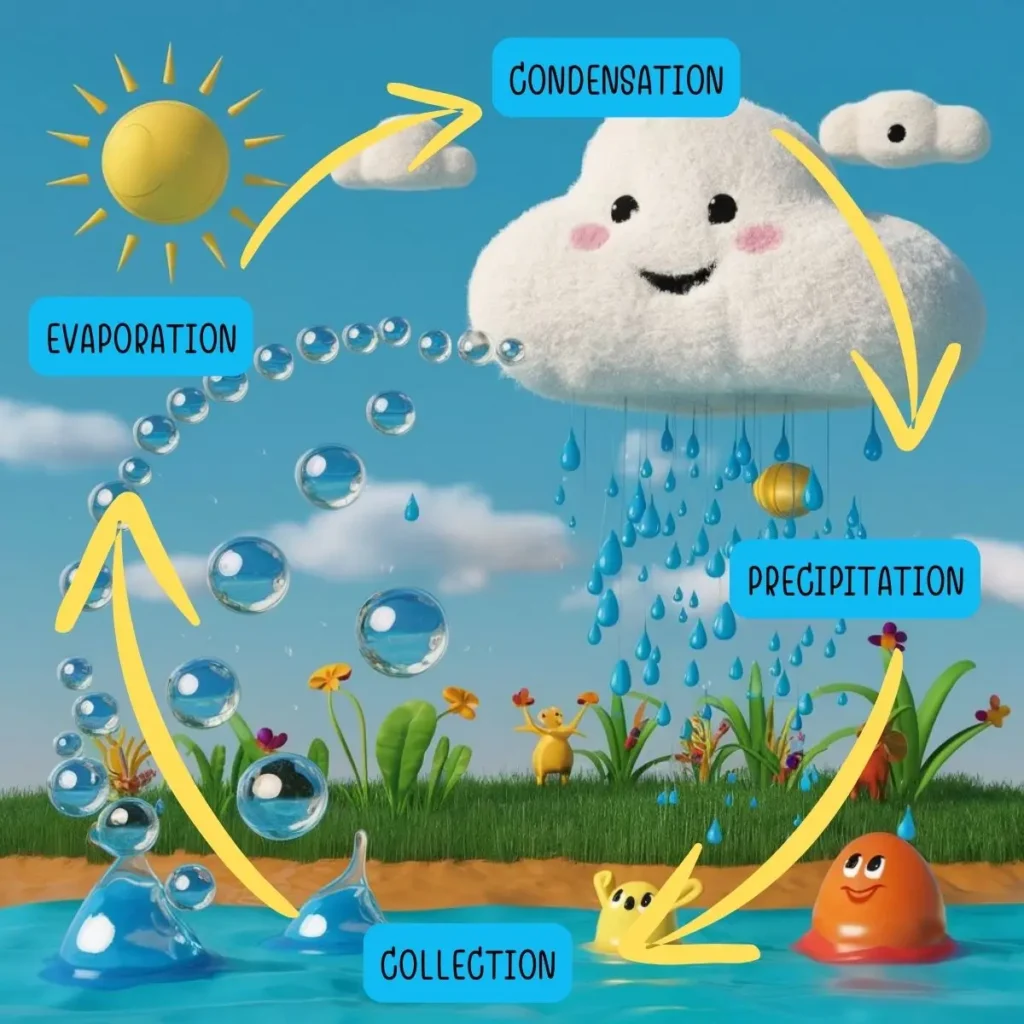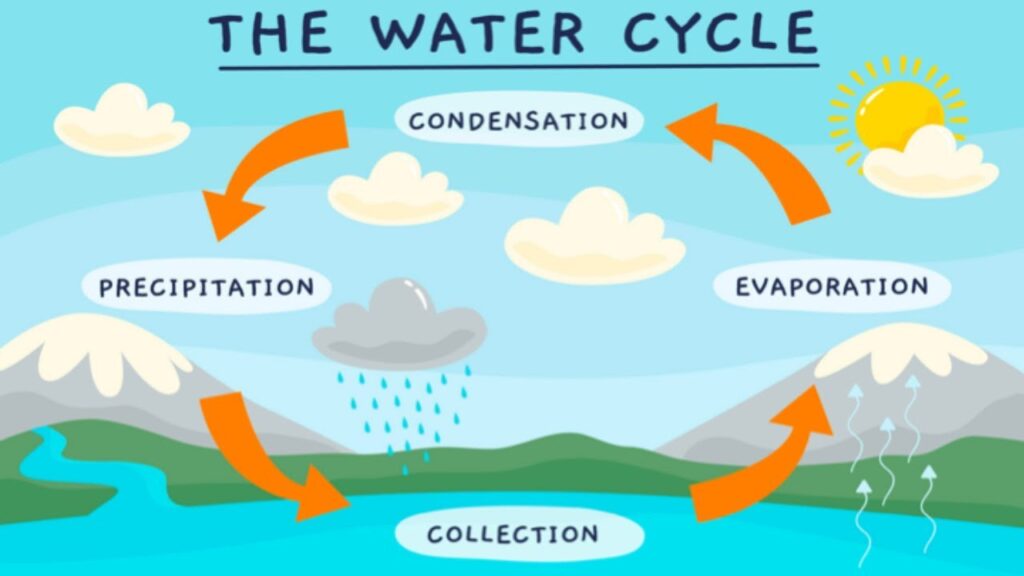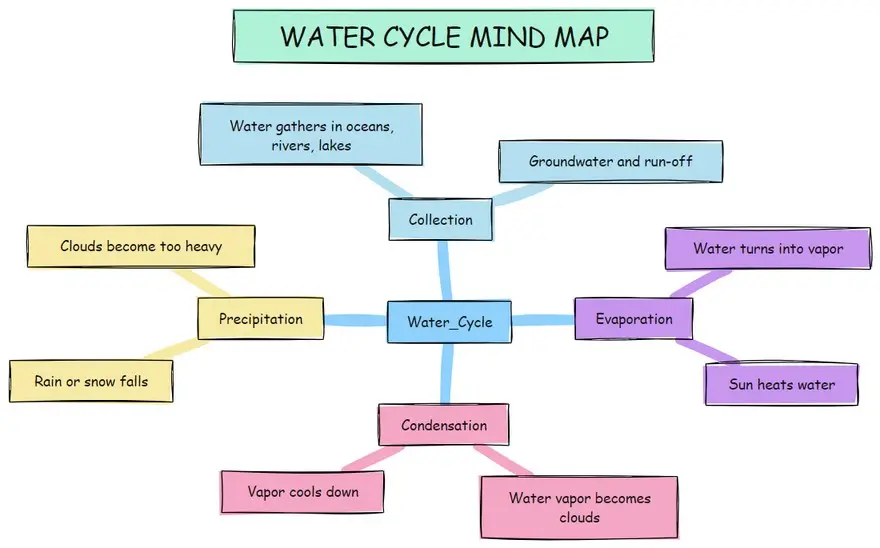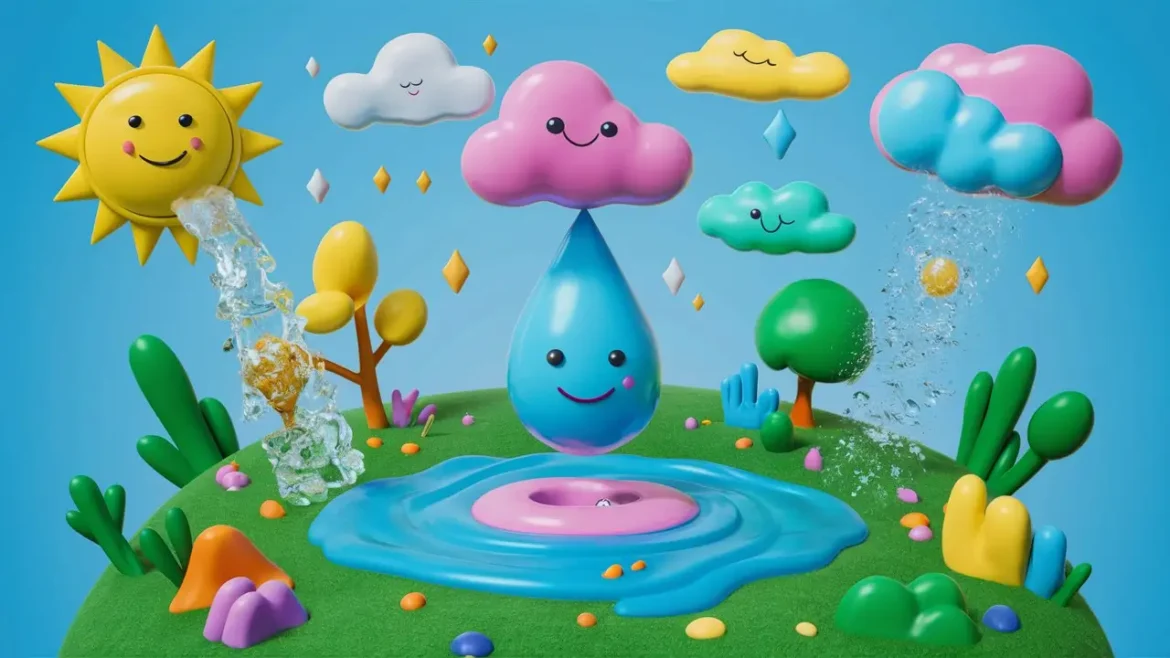Do your kids often ask you how a puddle dries up or where rain comes from? Here is a simple article explaining the 4 stages of water cycle for kids.
Explain they’re actually seeing the water cycle in action, a fascinating journey that water takes through four main stages: evaporation, condensation, precipitation, and collection.
This might sound simple, but there’s a lot more to discover about how these stages connect and what roles they play in keeping our planet alive.
Table of Contents
The Four Main Stages of the Water Cycle
The four main stages of the water cycle are: evaporation, condensation, precipitation, and collection.
Evaporation Stage: liquid water from oceans, lakes, rivers, and other bodies of water evaporates, turning into water vapor as it absorbs heat energy from the Sun.
Condensation Stage: This vapor rises into the atmosphere of Earth, where it cools down through condensation to form clouds.
Precipitation Stage: Once these clouds are full, precipitation occurs in the form of rain, snow, hail, or ice pellets.
Collection Stage: This precipitation replenishes freshwater sources like lakes and rivers, and also nourishes plants and trees through a process called collection.
Check out a water cycle diagram to see how these stages connect!

RELATED ARTICLE: Fun Questions to ask your kids
Evaporation Checklist:
To confirm you comprehend evaporation clearly, check if you can identify when water turns into vapor due to the Sun’s heat. This is the first essential step in the water cycle.
Evaporation leads to cloud formation, which eventually causes precipitation, completing a part of the cycle.
Here’s a simple checklist to help you nail down the essentials:
| Check | Ask your kid |
|---|---|
| Sun’s Heat | Is the water heating up from the sun? |
| Vapor Formation | Can you see or sense the steam or mist? |

Condensation Checklist:
After understanding evaporation, you’ll find that condensation is the next key step where the water vapor you learned about cools and forms clouds.
As this water vapor rises higher in the sky, it meets cooler atmospheric temperatures. This chilling effect changes the vapor into tiny liquid droplets.
These droplets cluster together to form the clouds you see above.
Here’s what to check for understanding condensation:
- Know that condensation is the opposite of evaporation; it turns water vapor back into liquid.
- Remember, it’s the cold temperatures high up in the atmosphere that make condensation happen.
- Recognize that clouds are made of these liquid droplets, which gather together before falling as precipitation.
This cycle is what keeps water moving around our planet!
Precipitation Checklist:
Understanding precipitation is essential to seeing how water returns to Earth in various forms like rain, snow, or hail. In the water cycle, this process is vital because it’s how liquid water gets stored back into lakes, rivers, and oceans.
When heavy clouds, fueled by solar energy, can’t hold any more water droplets, they release precipitation.
This can happen as rain if it’s warm, or as snowfall if it’s cold.
You’ve probably noticed how a rainy day can fill up puddles and make rivers look fuller. That’s precipitation at work!
It’s amazing how nature balances water on our planet, continuously recycling it through these stages. So, always remember, each drop of rain or flake of snow is part of this incredible cycle!

Collection Checklist:
Now let’s explore how water collects in places like oceans, lakes, and rivers once it falls as rain or snow. After precipitation, water travels and gathers, creating the essential reservoirs that sustain various life forms.
Here’s what you need to check to understand this stage:
- Surface Run-off: Water flows over land, collecting into larger bodies like rivers and lakes.
- Infiltration: Some of the water seeps into the soil, replenishing groundwater supplies.
- Collection in Water Bodies: Eventually, most of the water ends up in larger bodies such as oceans and lakes, waiting for evaporation to restart the cycle.
Understanding these processes will help you master how water moves through its cycle, constantly supporting life on Earth.

Additional Processes in the Water Cycle
If you are interested, we can dive deeper into the water cycle by exploring additional processes like sublimation and transpiration.
Sublimation is when snow or ice changes directly into vapor without becoming liquid first. This happens especially in really cold areas or high places where the sunshine hits the snow.
Transpiration occurs when plants absorb water through their roots and then release it as vapor from their leaves into the air. These processes add vapor to the atmosphere without any liquid water being visible!
Here’s a quick table to summarize these fascinating processes:
| Process | Description | Example |
|---|---|---|
| Sublimation | Ice/snow turns into vapor without becoming liquid | High mountain snow |
| Transpiration | Plants release water vapor | Forests and fields |
Understanding these helps you see how vapor clusters form and how underground water helps in reservoir filling.

Impact of the Water Cycle on Climate and Ecosystems
Exploring how the water cycle affects both climate and ecosystems shows its importance beyond just rainfall and evaporation. The water cycle is integral to distributing heat and moisture globally.
This not only influences weather patterns but also supports diverse habitats and life forms.

Here’s how the water cycle plays an important role:
- Heat Distribution: It regulates our planet’s temperature, ensuring some regions don’t get too hot or too cold.
- Moisture Regulation: It maintains the necessary balance of moisture in the air, which affects weather and climate.
- Environmental Conservation: By understanding the water cycle, you can engage in more sustainable management practices to preserve ecosystems and ensure resources are available for future generations.
This knowledge is essential for tackling today’s climate challenges.

Activities for kids to learn about 4 stages of water cycle
1. Test kids knowledge with printable worksheets
I’ve created a fun and interactive activity to help your child understand the four stages of the water cycle.
There are flashcards included, and your child will need to identify which stage each card represents. Have fun learning together!

2. Create Your Own Water Cycle
To help kids grasp the stages of the water cycle, you can start with a hands-on ‘Create Your Own Water Cycle’ activity. This visual and engaging method demonstrates evaporation, condensation, precipitation, and collection in a simple way.
Materials:
- Large bowl
- Small bowl
- Hot water
- Salt (optional)
- Plastic wrap
- Ice cubes
- Sticky tape
Step-by-Step Instructions:
- Add Salt (Optional): If you want to represent sea water, add 2 teaspoons of salt to the large bowl.
- Boil Water: Pour boiling water into the large bowl and mix until the salt dissolves.
- Create Evaporation: Place the small bowl in the center of the large bowl, making sure it’s higher than the water level but shorter than the edges of the large bowl. This represents the sun heating the water.
- Cover with Plastic Wrap: Use cling wrap to cover the large bowl. Secure it with sticky tape or a rubber band.
- Add Ice Cubes: Place a handful of ice cubes in the center of the cling wrap. This will cool the water vapor and help it condense.
- Wait and Observe: Wait for a few hours or until you see droplets of water forming on the plastic wrap. These droplets represent clouds. As they grow, they will eventually fall back into the small bowl, mimicking precipitation.
What’s Happening:
- The hot water in the large bowl represents the sun heating the Earth’s surface.
- The water vapor rises and cools, condensing into droplets on the plastic wrap, just like clouds form in the atmosphere.
- The droplets grow and eventually fall back into the small bowl, demonstrating precipitation.
Tips and Variations:
- You can add blue food coloring to the water for a more colorful representation of the water cycle.
- Use a fan to speed up the evaporation process.
- Repeat the experiment several times to see how the water cycle works continuously.
This experiment is a fun and interactive way for kids to learn about the water cycle, and it’s easy to set up and follow along.
3. Create Your Own Water Cycle
Try the ‘Cloud in a Bottle’ experiment to further explore condensation. Just a plastic bottle or a plastic bag, water, and a match are required to make clouds appear right before your eyes!
Here is a cool experiment for you to try:
For a creative twist, have kids make water cycle bracelets, using different colored beads to represent each stage. These activities not only educate but also make the learning process fun and memorable.
Conclusion
You’ve just explored the fascinating water cycle, where every drop of water on Earth travels through evaporation, condensation, precipitation, and collection.
Did you know that about 90% of the water vapor in the atmosphere comes from evaporation from oceans? That’s a lot of water moving around!
Understanding this cycle highlights its critical role in our climate and ecosystems. From glaciers to rivers, and lakes to groundwater, each phase—whether liquid, gas, or ice—maintains our freshwater resources.
By learning about these processes and emphasizing water conservation, we can better protect our planet and manage our vital water resources.




